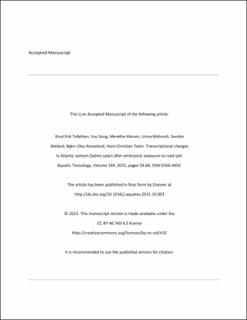| dc.contributor.author | Tollefsen, Knut Erik | |
| dc.contributor.author | Song, You | |
| dc.contributor.author | Kleiven, Merethe | |
| dc.contributor.author | Mahrosh, Urma | |
| dc.contributor.author | Meland, Sondre | |
| dc.contributor.author | Rosseland, Bjørn Olav | |
| dc.contributor.author | Teien, Hans-Christian | |
| dc.date.accessioned | 2020-11-30T14:47:22Z | |
| dc.date.available | 2020-11-30T14:47:22Z | |
| dc.date.created | 2015-12-09T14:12:15Z | |
| dc.date.issued | 2015 | |
| dc.identifier.citation | Aquatic Toxicology. 2015, 169, 58-68. | en_US |
| dc.identifier.issn | 0166-445X | |
| dc.identifier.uri | https://hdl.handle.net/11250/2690325 | |
| dc.description.abstract | An impressive portfolio of case-study research has now demonstrated how and through what means the BRICS (Brazil, Russia, India, China, South Africa) countries have sought higher social status. However, this field of research lacks systematic means of evaluating this status-seeking. This article fills this lacuna by developing a mixed-methods framework enabling scholars to zoom in and compare individual states’ relative status performance. Using diplomatic representation as a proxy for status recognition and comparing it to a country’s status resources (wealth), the framework indicates how successfully countries have generated recognition from the international society. The findings show that China’s economic ascent has been matched by increased recognition, and that South Africa enjoyed an almost immediate ‘status bounce’ following apartheid, turning it from a pariah to a significant overperformer. Russia should be understood as an ‘overperforming status-dissatisfied power’ while India’s status performance has been around ‘par’ for a country of its economic resources. Lastly, Brazil underperforms more than any of the other BRICS, especially since its democratic transition. The findings highlight considerable variance in the type and duration of gaps between status resource and recognition and suggests that rather than treating these as ‘inconsistencies’ awaiting correction, they can and should be accounted for by case study analyses. | en_US |
| dc.language.iso | eng | en_US |
| dc.rights | Attribution-NonCommercial-NoDerivatives 4.0 Internasjonal | * |
| dc.rights.uri | http://creativecommons.org/licenses/by-nc-nd/4.0/deed.no | * |
| dc.title | Transcriptional changes in Atlantic salmon (Salmo salar) after embryonic exposure to road salt | en_US |
| dc.title.alternative | Transcriptional changes in Atlantic salmon (Salmo salar) after embryonic exposure to road salt | en_US |
| dc.type | Peer reviewed | en_US |
| dc.type | Journal article | en_US |
| dc.description.version | acceptedVersion | en_US |
| dc.source.pagenumber | 58-68 | en_US |
| dc.source.volume | 169 | en_US |
| dc.source.journal | Aquatic Toxicology | en_US |
| dc.identifier.doi | 10.1016/j.aquatox.2015.10.003 | |
| dc.identifier.cristin | 1298844 | |
| dc.relation.project | Norges forskningsråd: 160016 | en_US |
| dc.relation.project | Norges forskningsråd: 223268 | en_US |
| dc.relation.project | Statens Vegvesen: NORWAT | en_US |
| cristin.unitcode | 192,14,0,0 | |
| cristin.unitname | Miljøvitenskap og naturforvaltning | |
| cristin.ispublished | true | |
| cristin.fulltext | postprint | |
| cristin.qualitycode | 2 | |

